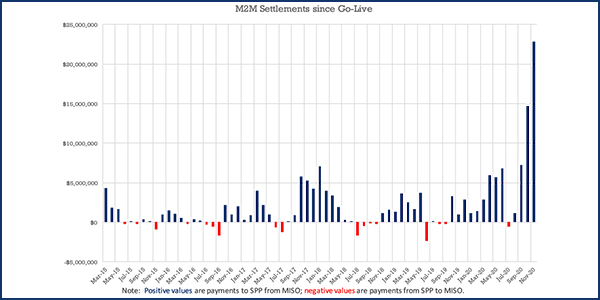SPP staff assured stakeholders they are looking into the causes of congestion around the MISO seam following a third straight month of record market-to-market (M2M) settlements.
SPP incurred $22.87 million from MISO in M2M settlements during November, a 56.3% increase from the $14.63 million in October. That mark more than doubled the previous high. (See Record $14.63M M2M Settlement for SPP, MISO.)
“Some of it [the spike in M2M settlements] is a ‘perfect storm’ scenario,” SPP’s Scott Brown told the Seams Steering Committee on Friday. “It was a combination of significant outages in certain areas, increased wind and a low mix of [firm-flow] entitlements [FFEs] in the areas where there is an increased use of the system along the seam.”
FFEs are allocated property rights to the RTOs, with each RTO calculating its real-time usage. The grid operators exchange M2M settlements for redispatch based on the non-monitoring RTO’s market flow in relation to its FFE.
“In general, one of the major causes for these M2M events and settlements is when the wind is high in both SPP and MISO,” said Clint Savoy, the SSC’s staff secretary.
Ten permanent flowgates were binding for 525 hours, resulting in $11.77 million in M2M settlements, while 36 temporary flowgates bound for 1,612 hours, accounting for $11.1 million in payments.
Pointing to a trouble spot on the western side of the Nebraska-Iowa border, SPP Director of System Planning Casey Cathey reminded the committee that the grid operator identified a potential interregional transmission project in the area last year. It failed to meet MISO’s benefit-to-cost ratio threshold.
The 161-kV Raun-Tekamah permanent flowgate in eastern Nebraska accounted for almost $5 million in settlements to SPP alone, binding for 198 hours. Cathey said the Raun area is one of the highest priorities for SPP’s 2021 Integrated Transmission Planning assessment and the joint transmission study with MISO. (See MISO, SPP Stakeholders Applaud New Joint Study.)
“You look at the locations of the [generator interconnection] queue for SPP and the locations of the queue for MISO, and intuitively, without running any studies, you understand that unless we build bigger pipes — more transmission — [the Raun area’s congestion] is going to continue,” Cathey said.
“It’s not going to drop down, but I don’t know that the magnitude will be as high for a sustainable period,” he said. “There’s nothing in the works that alleviates this congested area. The trend will continue, just not to that magnitude.”
Cathey hopes the Strategic and Creative Re-engineering of Integrated Planning Team (SCRIPT), which has been tasked with reviewing and possibly combining SPP’s seven different transmission planning processes, will be able to relieve some of the pressures on the grid. (See “SPC Takes Look at Tx Planning,” SPP Briefs: Week of Aug. 31, 2020.)
“All these different business functions operate on different timelines and for different reasons. I’m not saying it’s broken, but this is what happens,” he said. “That’s the big part of what we’re trying to do with SCRIPT and consolidation.”
SPP has piled up $140.23 million in settlements from MISO since the two grid operators began the M2M process. Under the process, the monitoring and non-monitoring RTOs manage M2M constraints by exchanging shadow prices and other information to ensure that the RTO with the more economic dispatch addresses flows. The shadow price indicates the marginal value of an additional increment of relief on a congested constraint in reducing the total production costs.
M2M settlements have been in SPP’s favor 13 of the last 14 months and 52 times in 69 months since the process began in 2015. The top 10 constrained flowgates since the process began all have MISO paying SPP, staff said.
SSC Supports Affected-system Studies
The SSC told staff it would approve a proposal to revise the queue priority for transmission projects in affected-systems studies with seams neighbors, but only if they are applied to all neighboring grid operators.
A majority of stakeholders in a snap poll during Friday’s webinar said they would support Associated Electric Cooperative Inc.’s (AECI) proposal to establish a relative queue priority for study requests between the cooperative and AECI.
Only three of the 15 respondents to the poll said they would not support AECI’s proposal.
Staff are also gathering feedback from the Generation Interconnection Users Forum.
SPP uses the studies to determine non-jurisdictional and neighboring interconnection requests’ effects on its transmission system. The studies take into account interconnection requests on neighboring grids, including those of AECI, MISO, Minnkota Power Cooperative and NorthWestern Energy.





